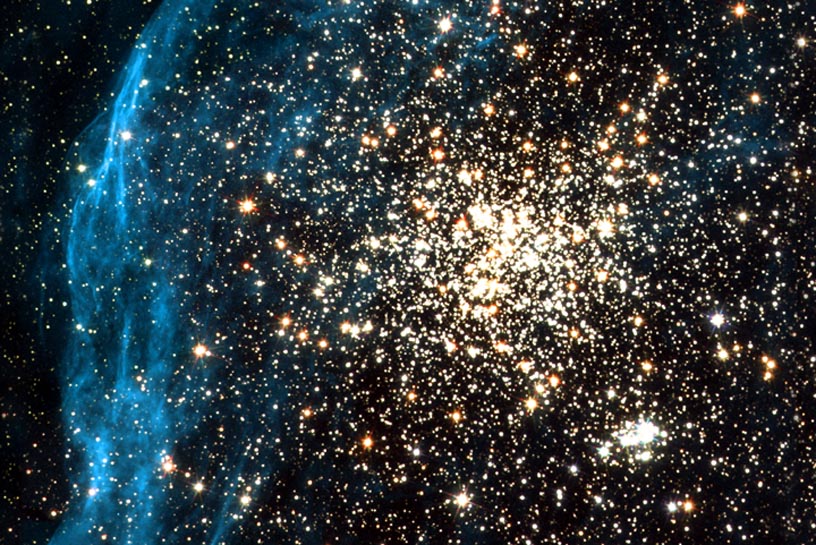
Remarkable Double Cluster
Star Cluster
RA 5h 8m 46.94s Dec -68° 45' 49.51"
Dorado
51.4 kpc (168,000 light-years)
9.0
NGC 1850 has a full diameter of about 3.5 arcminutes.
2.1 x 1.4 arcminutes across (102x68 light-years)
April 3, 1994 and February 6, 1996
1.9 hours
North is 47.9° right of vertical
NASA, ESA & Martino Romaniello (ESO, Germany)
July 10, 2001
Wide field view: S9920
ABOUT THIS IMAGE:
The double cluster NGC 1850 first discovered by James Dunlop on August 3, 1826, found in one of our neighboring galaxies, the Large Magellanic Cloud, is an eye-catching object. It is a young globular-like star cluster - a type of object unknown in our own Milky Way galaxy. Moreover, NGC 1850 is surrounded by a pattern of filamentary nebulosity thought to have been created during supernova blasts.
NGC 1850, imaged here with the NASA/ESA Hubble Space Telescope, is an unusual double cluster that lies in the bar of the Large Magellanic Cloud, a satellite galaxy of our own Milky Way. After the 30 Doradus complex, NGC 1850 is the brightest star cluster in the Large Magellanic Cloud. It is representative of a special class of objects -young, globular-like star clusters - that have no counterpart in our own Galaxy. The two components of the cluster are both relatively young and consist of a main globular-like cluster in the center and an even younger, smaller cluster, seen below and to the right, composed of extremely hot, blue stars and fainter red T-Tauri stars. The main cluster is about 50 million years old and the smaller cluster is only 4 million years old.
One of Hubble's main contributions to the study of NGC 1850 is in the investigation of star formation at both ends of the stellar mass scale - the low-mass T-Tauri stars and the high-mass OB stars.
T-Tauri stars are solar-class, young stars under formation, so young that they may have not started converting hydrogen to helium, which is how our Sun produces its energy. Instead they radiate energy released by their own gravitational contraction. By investigating these stars astronomers learn about the births and lives of low-mass stars. T-Tauri stars tend to occur in crowded environments, but are themselves faint, making them difficult to distinguish with ground-based telescopes. However, Hubble's fine angular resolution can pick out these stars, even in galaxies other than our own.
Hubble also has advantages when studying very massive stars. These stars emit large amounts of energetic ultraviolet radiation that is absorbed by the Earth's atmosphere. From its position above the atmosphere Hubble can detect ultraviolet light from these massive OB stars that can then be analyzed and used to characterize their properties. This Hubble image is a good example of the interaction between gas, dust and stars. Millions of years ago massive stars in the main cluster exploded as supernovae, forming the spectacular filigree pattern of diffuse gas visible in the image. It is believed that the birth of new stars can be triggered by the enormous forces in the shock fronts where the supernova blast waves hit and compress the gas. The nebula is part of the N103 superbubble and looks similar to the well-known supernova remnant, the Cygnus Loop, in our own Milky Way.
This image was created from five archive exposures obtained with Hubble's Wide Field Planetary Camera 2 through different filters. Deep blue represents 1000 seconds through a 428 nm filter, green 1500 seconds through a 552 nm filter, yellow 520 seconds through a 671 nm filter, red 1000 seconds through a 797 nm filter. In addition, light blue represents 3080 seconds through a 656 nm (H-alpha) filter.
The
full image is 2.1 x 1.4 arc-minutes across, corresponding to 96 x 67 light
years at the distance of the Large Magellanic Cloud. NGC 1850 lies in
the southern constellation of Dorado (the Goldfish, sometimes known as
the Swordfish) and its full diameter is about 3.5 arc-minutes.